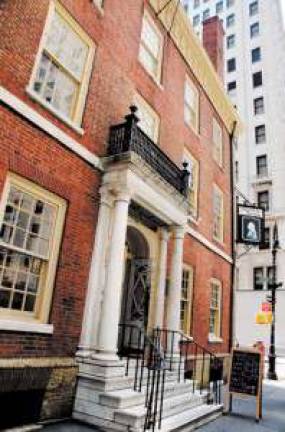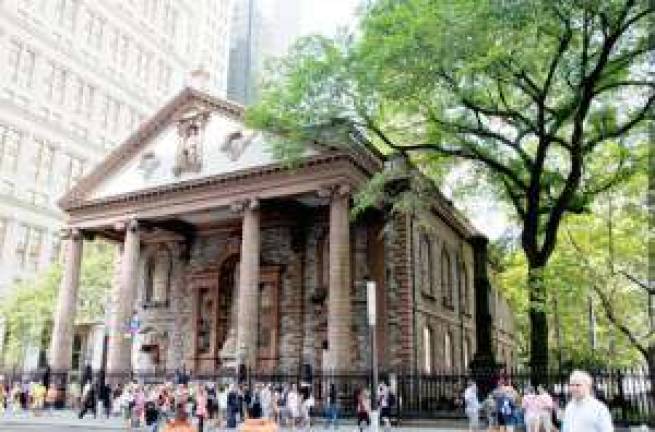Rats, Washington and the Titanic



The little-known past of the oldest buildings in Downtown Manhattan In Downtown Manhattan, where glass and steel skyscrapers create sleek urban canyons, it is difficult to picture the Wall Street area lined with genteel homes and churches. Yet despite devastating, widespread fires that wiped out most Downtown buildings, and two centuries of demolition and construction, three 18th-century structures still stand and remain the oldest buildings south of 14th Street.
Captain Joseph Rose House Joseph Rose was a successful importer of expensive Honduran mahogany.When he built his brick Georgian residence at 273 Water St. around 1773, before landfill extended the shoreline, the river ran just behind his elegant home.
Similar merchant-class homes lined Water Street in the late 18th century, but by the beginning of the 19th century, the area declined as encroaching commerce pushed residents away. The house was used as a cobbler's shop, an apothecary and, just before the Civil War, a boarding house. By mid-century, Water Street had become a "sea of wretchedness," as described by one contemporary writer, James D. McCabe, where "hideous women" and drunken sailors loitered.
In 1863, saloon keeper Christopher "Kit" Burns opened his Sportsmen's Hall in the house.Here gambling, bare-knuckle boxing and drinking attracted rowdy customers.The hall, however, was best known for its rat and dog fights. For $1.50-$5 (around $26-$87 today) patrons would see how quickly a dog could kill 100 rats. Between bouts, Burns' son-in-law, "Jack the Rat," would bite the head off of a live mouse for a dime. Burns' "Rat Pit" was among the most notorious of New York's saloons.
After the hall was closed in 1870, the building was used as a home for "fallen" women, in the vernacular of the day-prostitutes.
After a fire in 1904, it was used as a warehouse until another fire in 1974 gutted the building.Today, the captain's former home has been renovated into luxury apartments. Where Jack the Rat once bit the heads off of mice, apartments now sell for just over $1 million.
Fraunces Tavern George Washington indeed slept here-but he hadn't even been born when it was built.In 1719, French-born Stephan DeLancey completed his four-story brick home at Pearl and Broad streets.The impressive mansion was entered through an elegant doorway framed by a columned portico.
While Col. Beverly Robinson, a loyalist and friend of Benedict Arnold, was living here in 1756, Washington stayed as a guest before returning to the Indian Wars. Samuel Fraunces, a Frenchman from the West Indies, bought the home at auction in 1762 and converted it into The Queen's Head Tavern.
An important meeting place for revolutionists, the tavern included a dungeon below for prisoners of war and the upstairs meeting rooms were used as the offices of the newly formed departments of War, Treasury and Foreign Affairs. But it was Washington's emotional farewell to his troops in the Long Room, a private dining and meeting room, that Americans most remember.
Devastated by fire in 1854, it was later renovated but its historical importance was long forgotten, until the Daughters of the American Revolution rediscovered it in 1895.In 1907, after years of restoration, Fraunces Tavern re-emerged as the building we can see today.
St. Paul's Chapel St. Paul's Chapel, at Broadway and Fulton Street, sat in a wheat field when it was completed in 1766. Although architect Thomas McBean faced the chapel away from Broadway to take full advantage of the river view, two years later a graceful carriage portico was added on Broadway, creating what we recognize today as the front.
A fire ravaged the city in September 1776, destroying 25 percent of its buildings, including the 1698 Trinity Church. St. Paul's, then at the northern rim of the city, became George Washington's place of worship, and he prayed here prior to his inauguration.
The chapel held memorial services for the victims of the sinking of the Titanic in 1912 and in 2001 for those lost in the World Trade Center terrorist attacks.Used as a place of rest for workers on "the pile," today the interior of the oldest existing church building in New York City is draped with memorial banners.
-- Tom Miller is author of the historical architecture blog Daytonian in Manhattan. A transplanted Buckeye, he moved to New York in 1979 and has never stopped being a tourist.